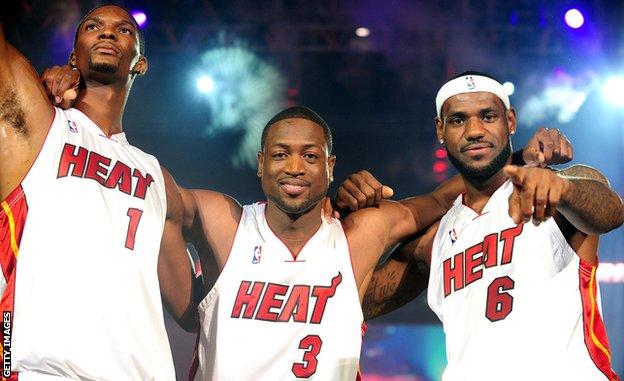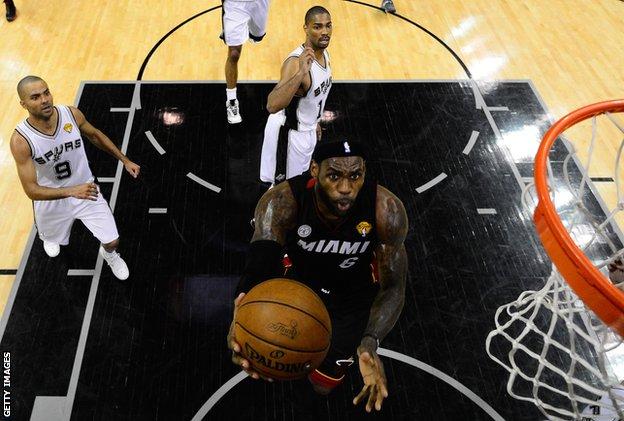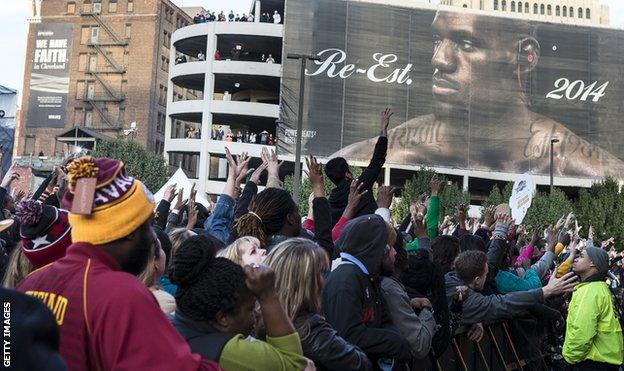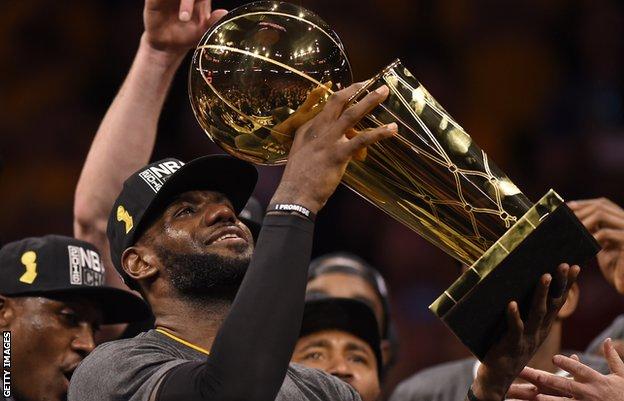The Superstar – 2010-2014
Donewald was on his way out of London’s Olympic Stadium when he was tackled to the ground by “what I thought was a bear”.
As coach of the Chinese basketball team for the 2012 Games, he’d led a procession around the track for the opening ceremony. As his players made their exit through the tunnel, Team USA were about to enter.
“Elvis!” Donewald shouted, recognising the six-foot-nine ‘bear’ that had wrestled him to the deck.
“We did it! We did it!” James was shouting.
A month earlier, James had claimed his first NBA title and was named Finals MVP as the Miami Heat overcame the Oklahoma City Thunder by four games to one. He’d also been named regular-season MVP for the third time.
James’ move to Miami in 2010 was tinged with controversy. Many fans and league insiders felt announcing which team he’d join in free agency via a live television special, entitled The Decision, was in bad taste.
“I’m going to take my talents to South Beach,” James said on the air, paraphrasing a teenage Kobe Bryant’s announcement that he was skipping college to join the NBA in 1996. Cavaliers fans were crushed.
But James’ decision – if not The Decision – was vindicated by his success in Florida, where he linked up with fellow perennial All-Stars Dwayne Wade and Chris Bosh to create one of the most-feared ‘super teams’ the NBA has ever seen.

The Heat reached four straight Finals, winning twice – in 2012 and 2013 – and James took his MVP haul to four, just two shy of Kareem Abdul-Jabbar’s record of six, and one behind Michael Jordan and Bill Russell.
James turned 28 midway through the Heat’s 2012-13 championship-winning season. He was at his peak; the full realisation of his teenage promise.
Orlando Johnson was part of the Indiana Pacers team that faced James and the Heat in the Eastern Conference Finals that year. A rotation player in the same position, Johnson knew the task of stopping the unstoppable would fall to him in the minutes he saw.
“He sees the court like no other and he could do it all,” Johnson says. “He could hit the mid-range; that’s when his three-ball was really starting to take off. Just how strong he was; I think he might have been a little bit bigger then – 270, 280 pounds maybe. His passing ability, and just his speed. His speed was off the charts.
“Trying to keep this guy in front, it was like, man, this is a different beast. During that time especially, he might have been at peak athleticism.
“I think what I respected in him the most was the way he could lock in on a game when it’s go-time. You hear about his Game 7 performances throughout his career. He doesn’t really lose those games.”

The series had been close, but the deciding game was a blowout. The Heat won by 13 points and James led all scorers with 32 while also contributing eight rebounds and a team-high four assists. They would face the Spurs in the Finals, and James would claim revenge for 2007’s heartbreak thanks to a series-best 25.3 points per game in another 4-3 victory.
“We saw the levels he could take it to,” Johnson adds. “At that time, I don’t think any of us could reach it. When he locked in and took it to another level, it was different.
“A guy like him, he’s going to go down as one of the greatest to ever play the game.”
The Leader – 2014-2018
In 2014, James decided to reverse The Decision and take his talents back to Cleveland. In the Heat’s fourth consecutive Finals appearance, just a few months before, they’d lost in five games to the Spurs. James opted out of his contract and returned to the Cavaliers as a free agent.
In the four years he’d been away, Cleveland had compiled the worst overall win-loss record (97-215) in the NBA. They finished 10th in the Eastern Conference for 2013-14.
In Miami, James was the centrepiece of a superstar ensemble. Continuing his quest for championships in Cleveland – who had no NBA titles to their name – would require an effort of leadership as much as skill.

With gifted young point guard Kyrie Irving already on the roster and All-Star power forward Kevin Love acquired from the Minnesota Timberwolves, James’ Cavaliers were not without talent, but the group would need inspiration and winning nous.
“I think it’s the balance of knowing how good you are and at the same time respecting your team-mates and knowing you need them to win,” says Jose Calderon, who played for the Cavaliers during the 2017-18 season.
“Some guys forget about that. He doesn’t. He’s a great team-mate. He was amazing. He was the first one there, and he worked every day. There were no days off.”
James led the Cavaliers to the NBA Finals in each of the four years of his second spell in Cleveland, taking his personal tally of consecutive Finals appearances to eight. Those around him noticed how he once again elevated his game during the playoffs, year after year.
“He was so ready for that,” Calderon says. “For some players, it’s difficult to turn it on and off, but you could see he had one more level that was 1,000 times more of everything. More focused. More rest. More rehab. More of anything he needed to do to be ready.”
Had they not coincided with the Golden State Warriors team of Steph Curry, Klay Thompson, Draymond Green and, from 2016, Kevin Durant, the Cavaliers might have collected more championship rings. The one they did win, though, will be forever remembered among the greatest NBA upsets.

Trailing the Warriors 3-1 for the 2016 title, Cleveland fought back to claim a miraculous 4-3 triumph – a comeback on that scale had never been pulled off before in Finals history.
“Cleveland, this is for you!” an emotional James screamed at the end of his post-game interview on the court. He had delivered the city’s first professional sports title. All was forgiven for his years in Miami.
Alongside Irving’s winning shot in Game 7, James’ chase-down block on Andre Iguodala – sprinting to leap and swat away a lay-up attempt – was the iconic play of the series.
It is telling that a signature play in the career of one of basketball’s greatest and most complete offensive talents is a hustle effort on defence to snuff out what seemed a certain score for the opposition.
“That just showed the commitment,” says Neal Meyer, an NBA executive who served as a video co-ordinator for the Cavaliers in 2009-10. “Giving a little bit extra effort to get there and make that block, which changed everything.”
Calderon says: “When people ask me about LeBron, I always say: he’s maybe not the best scorer; he’s maybe not the best rebounder; he’s maybe not the best with assists. But all around, I think he’s the best player. He’s the most complete player.
“He can play defence. He can see the floor; he can see his team-mates. He knows what he wants in every moment of the game. I think that’s what sets him apart.
“They can’t do what he can do on the court.”